|
|
|
Sort Order |
|
|
|
Items / Page
|
|
|
|
|
|
|
| Srl | Item |
| 1 |
ID:
049521
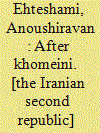

|
|
|
|
|
| Publication |
London, Routledge, 1995.
|
| Description |
xv, 244p.
|
| Standard Number |
0415108780
|
|
|
|
|
|
|
|
|
|
|
|
Copies: C:1/I:0,R:0,Q:0
Circulation
| Accession# | Call# | Current Location | Status | Policy | Location |
| 036689 | 320.955/EHT 036689 | Main | On Shelf | General | |
|
|
|
|
| 2 |
ID:
184390


|
|
|
|
|
| Summary/Abstract |
Systemic shift, in which the weight of the global economy has shifted away from the Euro-Atlantic eastwards, is increasingly underlined by what is referred to here as the ‘Asianisation of Asia'. Asianisation is a process in which Asia's diverse regions steadily converge around shared economic agendas. Japan, followed by the so-called ‘Asian Tigers’, were the pioneers of the Asian process, which began in earnest in the mid-1960s. China and India, drivers of the pre-modern world economy, are emulating the strategies of the early Asianisers this century and are building parallel pan-Asian relations of their own. Nowhere is this more evident, and indeed significant, than in relation to China and Iran, the Asianisers par excellence. Their relations are arguably critical to the process, a process which is infused with the legacy and their collective memories of the ancient Silk Road which had shaped pan-Asian relations for centuries before the rise of European power.
|
|
|
|
|
|
|
|
|
|
|
|
|
|
|
|
| 3 |
ID:
001061


|
|
|
|
|
| Publication |
Emirates Center for Strategic Studies and Research, 1998.
|
| Description |
62p.
|
| Series |
Emirates Occasional paper;16
|
|
|
|
|
|
|
|
|
|
|
|
Copies: C:1/I:0,R:0,Q:0
Circulation
| Accession# | Call# | Current Location | Status | Policy | Location |
| 040563 | 327.112095/EHT 040563 | Main | On Shelf | General | |
|
|
|
|
| 4 |
ID:
177209


|
|
|
|
|
| Summary/Abstract |
Global energy trade in hydrocarbons is being significantly re-oriented from the Atlantic basin to the Asia-Pacific region, with energy markets shifting their focus along the same patterns as the global economy –– towards the Asia-Pacific. The net result has been the centre of gravity of energy moving towards Asia and its large and emerging economies. The world is at the same time becoming a system of “world regions” and more urbanized, with the share of population of LDCs living in urban areas rising from 46% in 2014 to 57.9% in 2035. An emerging world region is arguably continental Asia in which East, Central, South and West Asia play a shaping part and developing its “Asianization”. It is argued here that economic orientation and urbanization trends will significantly impact global, and particularly Asian, energy markets thus determining the course of action of energy exporters of the GCC countries, and those of Central and West Asia. In Asia’s uneven energy markets, while China will lead energy demand growth in Asia in the 2020s, it will be India which likely will take up China’s mantle after 2025, thus maintaining and deepening the Persian Gulf’s “Asianization” and Asian energy interactions as part of a deeper integration of Asian economies.
|
|
|
|
|
|
|
|
|
|
|
|
|
|
|
|
| 5 |
ID:
079381
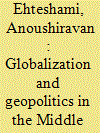

|
|
|
|
|
| Publication |
London, Routledge, 2007.
|
| Description |
x, 258p.
|
| Standard Number |
9780415426329
|
|
|
|
|
|
|
|
|
|
|
|
Copies: C:1/I:0,R:0,Q:0
Circulation
| Accession# | Call# | Current Location | Status | Policy | Location |
| 052748 | 303.48256/EHT 052748 | Main | On Shelf | General | |
|
|
|
|
| 6 |
ID:
079756
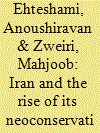

|
|
|
|
|
| Publication |
London, I B Tauris, 2007.
|
| Description |
xix, 215p.hbk
|
| Standard Number |
9781845113889
|
|
|
|
|
|
|
|
|
|
|
|
Copies: C:1/I:0,R:0,Q:0
Circulation
| Accession# | Call# | Current Location | Status | Policy | Location |
| 052892 | 955.054/EHT 052892 | Main | On Shelf | General | |
|
|
|
|
| 7 |
ID:
094117
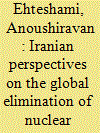

|
|
|
| 8 |
ID:
190778
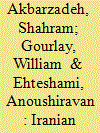

|
|
|
|
|
| Summary/Abstract |
This article examines Iran’s ‘forward-defence’ strategy, in particular its deployment of proxy forces in the Syrian conflict. Iran’s expanded presence in regional conflicts is regarded by its adversaries as indication of hegemonic intent, while Tehran posits its regional posture as a defensive response to security threats. We argue that Iran’s ‘forward-defence’ strategy offers practical benefits, shaping strategic realities, and performative benefits, allowing Tehran to propagate a discourse of military fortitude. On balance, however, the strategy has fed suspicions of Iran’s intentions and increased hostility towards the Iranian leadership, thus is likely to be counterproductive.
|
|
|
|
|
|
|
|
|
|
|
|
|
|
|
|
| 9 |
ID:
155561
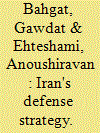

|
|
|
| 10 |
ID:
051843


|
|
|
|
|
| Publication |
Spring 2004.
|
| Summary/Abstract |
Iran's interwoven and complex domestic political structures should be set against an equally complex, dynamic, and unstable regional system, if one is to understand fully the relationship between the domestic and regional forces governing Iran's foreign policy-making. These matters are addressed in this article in the context of the new regional realities created by the fall of the Iraqi regime in April 2003
|
|
|
|
|
|
|
|
|
|
|
|
|
|
|
|
| 11 |
ID:
016935


|
|
|
|
|
| Publication |
April 1994.
|
| Description |
29-37
|
|
|
|
|
|
|
|
|
|
|
|
|
|
|
|
| 12 |
ID:
069599


|
|
|
|
|
| Publication |
Santa Monica, Rand Corporation, 2001.
|
| Description |
xx, 113p.
|
| Standard Number |
0833029711
|
|
|
|
|
|
|
|
|
|
|
|
Copies: C:1/I:0,R:0,Q:0
Circulation
| Accession# | Call# | Current Location | Status | Policy | Location |
| 044830 | 355.033055/BYM 044830 | Main | On Shelf | General | |
|
|
|
|
| 13 |
ID:
091959
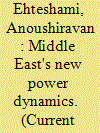

|
|
|
|
|
| Publication |
2009.
|
| Summary/Abstract |
Relations among the regional powers in the Middle East continue to dominate global conerns about security. As we watch the era of George W. Bush fade into history, we are still saddled with the consequences of politics that unleashed US military might in the region and, in the process, caused substanial imbalances among the regional powers that have proved difficult to redress.
|
|
|
|
|
|
|
|
|
|
|
|
|
|
|
|
| 14 |
ID:
033661
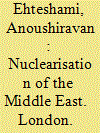

|
|
|
|
|
| Publication |
London, Brassey's, 1989.
|
| Description |
xii, 189p.
|
| Standard Number |
0080373453
|
|
|
|
|
|
|
|
|
|
|
|
Copies: C:1/I:0,R:0,Q:0
Circulation
| Accession# | Call# | Current Location | Status | Policy | Location |
| 030988 | 355.825119/EHT 030988 | Main | On Shelf | General | |
|
|
|
|
| 15 |
ID:
054365


|
|
|
| 16 |
ID:
079088


|
|
|
|
|
| Publication |
2007.
|
| Summary/Abstract |
The oil monarchies of the Persian Gulf region have typically been portrayed as patriarchal autocracies characterized by traditional tribal rule that have taken on the characteristics of a modern state. The historical debate on these rentier states has centred on how their substantial oil income since the 1970s has allowed them to pacify their citizenry from making demands for enfranchisement. Power was thus firmly able to rest with the elites. Since the end of the Cold War, winds of change flamed the desire for reform and the late 1990s saw significant political changes. The empirical data indicates that this pace has increased, albeit at differential speeds, within the context of the post-9/11 war on terror. Interestingly, this has been the case despite turmoil in Iraq and a shift to the right in Iranian politics. The fundamental drivers of reform in the Arab oil monarchies continue to be the ruling elites themselves, however. The character of the reforms does appear to be mainly liberalizing rather than democratizing, but developments in some oil monarchies suggest that this process can be viewed as an early or intermediate stage of a wider enfranchisement of civil society
|
|
|
|
|
|
|
|
|
|
|
|
|
|
|
|
| 17 |
ID:
081924


|
|
|
|
|
| Publication |
Berkshire, Ithaca press, 2008.
|
| Description |
x, 309p.hbk
|
| Standard Number |
9780863723230
|
|
|
|
|
|
|
|
|
|
|
|
Copies: C:1/I:0,R:0,Q:0
Circulation
| Accession# | Call# | Current Location | Status | Policy | Location |
| 053560 | 956/EHT 053560 | Main | On Shelf | General | |
|
|
|
|
| 18 |
ID:
145135
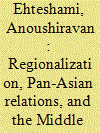

|
|
|
|
|
| Summary/Abstract |
Research on the emerging links between the Middle East (West Asia) and other parts of Asia has grown considerably since late twentieth century. Indeed, the contributions to this special edition of the journal reflect some of the pioneering work taking place on pan-Asian relations encompassing new analysis of the Middle East’s links with the ‘East’—Central, South, and East Asia. The research in this field, looking back into history as well as forward, has grown in response to the changing dynamics of intra-Asian relations following the end of the Cold War in 1990 and the collapse of the Soviet Union as a Eurasian land empire just a year later. The end of bipolarity encouraged new transnational relations and further regionalization of a new world order. As multi-polarity has steadily given way to a state of non-polarity, so the veil has also been lifted on the significant economic and political ties which have grown across strategic regions. In considering strategic regions, it is contended here that Asia is home to the most dynamic of these, in terms of asset accumulation, geopolitical weight, population size, and economic prowess. But it is also significant for the volatility which appears along the fault lines of historical animosity, national security tensions, modern-day rivalries, border and resources disputes, and the strengthening of communalism and divisive role of identity politics. Moreover, the collapse of the Soviet control of much of Central Asia opened up new spaces for exchange in Asia, much encouraged by the exploitation of hydrocarbon reserves of the Soviet successor states in Asia (also Azerbaijan in the Caucasus). But, pan-Asian ties predate the post-Cold War transformations of the global system, and several Asian powers were able to negotiate mutually beneficial links soon after the Second World War. Although evidence of ancient pan-Asian relations is to be found in the Silk Road, systemic shift in our time is clearly leading to a perceptible transfer of the global economic balance Eastwards, which has brought with it the rise of energy-hungry Asian economies in the twenty-first century. Asian demand for energy has changed the complexion of Middle East-Asia relations, and pan-Asian relations in this context are today a reflection of the changing contours of the global political economy.
|
|
|
|
|
|
|
|
|
|
|
|
|
|
|
|
| 19 |
ID:
163645


|
|
|
|
|
| Summary/Abstract |
Ever since the 1980s, the MENA subsystem has been weakening under the weight of persistent inter-state conflict, violent non-state and sub-state actor incursions, and intense competition for influence and geopolitical advantage amongst its core states. Furthermore, a domino-like collapse of autocratic regimes across the Arab region after 2010 heralded an unprecedented level of disorder, insecurity and chaos. Regional disorder and the general crisis of the state in the Arab region has aggravated regional fragmentation and has at the same time emboldened Saudi Arabia and a small group of its neighbours to adopt a more interventionist, and at times belligerent foreign policy posture. The region’s changing dynamics provide the backdrop for closer analysis of Saudi responses to the regional crisis, which itself has been shaped by the changing of the guard in the Kingdom in 2015. The change is marked by an intensification of Saudi activism and a deepening of its role as a resurgent regional power.
|
|
|
|
|
|
|
|
|
|
|
|
|
|
|
|
| 20 |
ID:
184389
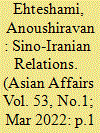

|
|
|
|
|
| Summary/Abstract |
In the fifty years since the People’s Republic of China and Iran formally established diplomatic relations, both states have undergone seismic changes in their domestic environments and foreign relations. In 1971, when the two states formalised their ties, Chairman Mao Zedong oversaw China’s accession to the United Nations following over two decades of autarky and revisionist ambitions, heralding the beginning of the People’s Republic of China’s impressive rise following his death in September 1976 and Deng Xiaoping’s subsequent drive for economic modernisation and reform. Meanwhile, the Shah of Iran, supported by the United States, occupied what appeared at the time to be a stable position as a pillar of Persian Gulf regional security, a role that could not be further removed from that played by the Islamic Republic following the 1979 revolution. Since then, both China and Iran, for different reasons and in different contexts, have been at the forefront of global international relations. In the case of China, its clout has skyrocketed in both economic and diplomatic terms. Its economy is poised to overtake that of the United States, and it has built extensive networks of economic and political interdependencies across the globe. Beijing not only weathered the storms that erupted following the Asian Financial Crisis in 1997 and the Global Financial Crisis a decade later but thrived in their aftermath.
|
|
|
|
|
|
|
|
|
|
|
|
|
|
|
|
|
|
|
|
|